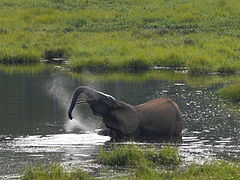Mbeli Bai
You can help expand this article with text translated from the corresponding article in Catalan. (February 2024) Click [show] for important translation instructions.
|
| Mbeli Bai | |
|---|---|
 African forest elephants in Mbeli Bai, 2011 | |
| Location | Nouabalé-Ndoki National Park |
| Nearest city | Lipendja, Republic of the Congo |
| Coordinates | 2°15′30″N 16°24′42″E / 2.2583°N 16.4117°E |
| Area | 12.9 hectares |
| Established | 1993 |
| Governing body | Wildlife Conservation Society Ministry of Forest Economy and Environment |
Mbeli Bai is a 12.9 hectare protected freshwater swamp forest, part of the Sangha Trinational Forest and the Western Congolian swamp forests ecoregion, in the Nouabalé-Ndoki National Park in the Republic of the Congo. The area is commonly used for research on wild gorillas and elephants.
History
[edit]In 1993, the Wildlife Conservation Society, together with the Ministry of Forest Economy and Environment, protected the swamp from human settlement.[1] The area is inhabited by African forest elephants, sitatunga, black-and-white colobus monkeys, Congo clawless and spotted-necked otter, and around 226 western lowland gorillas[2] found in groups of between 2 and 16 individuals.[3]
Animal research
[edit]Mbeli Bai is commonly used for animal research. Since February 1995, researchers working for Mbeli Bai's research group, Mbeli Bai Study (MBS), have been monitoring the animals in Mbeli Bai. The Mbeli Bai Study is funded by the Columbus Zoo and Aquarium, the Cologne Zoological Garden, the Dublin Zoo, the Toronto zoo, and the Wildlife Conservation Society, and the Woodland Park Zoo, in exhange for receiving animals.[4][5]
More than 330 gorillas have been monitored spanning more than 1750 gorilla years of around 55 groups of silverback gorillas. The researchers monitored gorilla socialisation[6] and power structures[7][8] and the first tool use by gorillas.[9][10][11]
Poaching
[edit]The area had some elephant poaching during the 1990s.[12][13] During the late 2000s and the 2010s, a poaching group led by Guyvanho killed around 500 elephants in the area. On August 19, 2020, he and his group were arrested, and Guyvanho was sentenced to 30 years in prison.[14][15]
Gallery
[edit]- Mbeli Bai
-
Mbeli Bai on a map
-
Female western lowland gorilla Efi, the first gorilla spotted using tools, Mbeli Bai, 2005
-
Elephant in marsh, Mbeli Bai, 2015. Photo by the United States Fish and Wildlife Service
References
[edit]- ^ Minteer, Ben A.; Maienschein, Jane; Collins, James P. (2018-02-23). The Ark and Beyond: The Evolution of Zoo and Aquarium Conservation. University of Chicago Press. ISBN 978-0-226-53863-1.
- ^ "Nouabale-Ndoki National Park". 2022-09-30. Archived from the original on 2022-09-30. Retrieved 2024-01-28.
- ^ Robbins, Andrew M.; Manguette, Marie L.; Breuer, Thomas; Groenenberg, Milou; Parnell, Richard J.; Stephan, Claudia; Stokes, Emma J.; Robbins, Martha M. (2022-10-19). "Population dynamics of western gorillas at Mbeli Bai". PLOS ONE. 17 (10): e0275635. Bibcode:2022PLoSO..1775635R. doi:10.1371/journal.pone.0275635. ISSN 1932-6203. PMC 9581538. PMID 36260834.
- ^ Breuer, T.; Manguette, M.; Groenenberg, M. (2018-03-02). "Gorilla Gorilla spp conservation – from zoos to the field and back: examples from the Mbeli Bai Study". International Zoo Yearbook. 52 (1): 137–149. doi:10.1111/izy.12181. ISSN 0074-9664.
- ^ Manguette, Marie L.; Greenway, Kelly W.; Kandza, Vidrige H.; Hockemba, Mireille Breuer-Ndoundou; Franck B., Franck B.; Parnell, Richard J.; Breuer, Thomas (2017). "Life-history patterns of the Sitatunga (Tragelaphus spekii) at Mbeli Bai, northern Congo" (PDF). African Journal of Ecology. 55 (2): 244. Bibcode:2017AfJEc..55..244M. doi:10.1111/aje.12321.
- ^ Parnell, R. J.; Buchanan-Smith, H. M. (2001). "Animal behaviour. An unusual social display by gorillas". Nature. 412 (6844): 294. doi:10.1038/35085631. PMID 11460152. S2CID 4338851.
- ^ Parnell, Richard J. (2002-03-07). "Group size and structure in western lowland gorillas (Gorilla gorilla gorilla) at Mbeli Bai, Republic of Congo". American Journal of Primatology. 56 (4): 193–206. doi:10.1002/ajp.1074. ISSN 0275-2565. PMID 11948636. S2CID 41772518.
- ^ "Gorillas found to live in 'complex' societies, suggesting deep roots of human social evolution". University of Cambridge. 2019-07-10. Retrieved 2024-01-28.
- ^ Breuer, T.; Ndoundou-Hockemba, M.; Fishlock, V. (2005). "First Observation of Tool Use in Wild Gorillas". PLOS Biology. 3 (11): e380. doi:10.1371/journal.pbio.0030380. PMC 1236726. PMID 16187795.
- ^ "Wild Gorillas Handy with a Stick". PLOS Biology. 3 (11): e385. 2005. doi:10.1371/journal.pbio.0030385. PMC 1236727.
- ^ "Wild gorillas spotted using tools for first time". NBC. 29 September 2005.
- ^ Robbins, Martha M.; Boesch, Christophe (2011-06-13). Among African Apes: Stories and Photos from the Field. University of California Press. ISBN 978-0-520-26710-7.
- ^ "Mbeli Bai, N. Congo". pages.ucsd.edu. Retrieved 2024-01-28.
- ^ Cockburn, Harry (16 August 2020). "Congo elephant poacher jailed for 30 years in landmark case". The Independent.
- ^ Gross, L. (2007). "In the Shadows of the Congo Basin Forest, Elephants Fall to the Illegal Ivory Trade". PLOS Biology. 5 (4): e115. doi:10.1371/journal.pbio.0050115. PMC 1845160. PMID 20076667.




